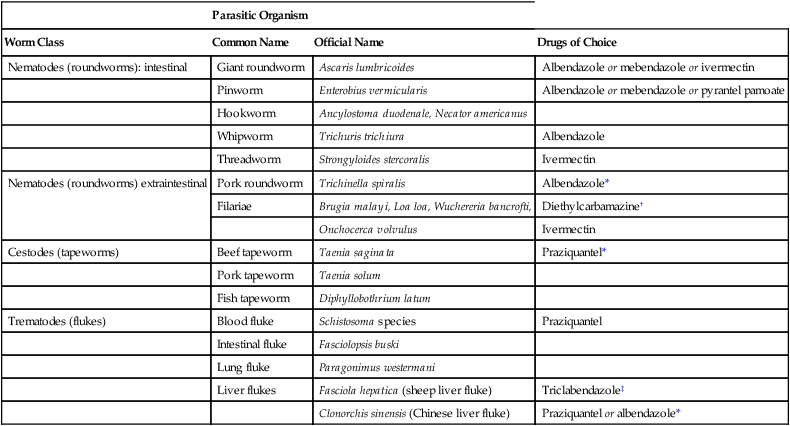TABLE 97–1 
Drugs of Choice for Parasitic Worms
|
Parasitic Organism |
|
Worm Class |
Common Name |
Official Name |
Drugs of Choice |
Nematodes (roundworms): intestinal |
Giant roundworm |
Ascaris lumbricoides |
Albendazole or mebendazole or ivermectin |
|
Pinworm |
Enterobius vermicularis |
Albendazole or mebendazole or pyrantel pamoate |
|
Hookworm |
Ancylostoma duodenale, Necator americanus |
|
|
Whipworm |
Trichuris trichiura |
Albendazole |
|
Threadworm |
Strongyloides stercoralis |
Ivermectin |
Nematodes (roundworms) extraintestinal |
Pork roundworm |
Trichinella spiralis |
Albendazole* |
Filariae |
Brugia malayi, Loa loa, Wuchereria bancrofti, |
Diethylcarbamazine† |
|
Onchocerca volvulus |
Ivermectin |
Cestodes (tapeworms) |
Beef tapeworm |
Taenia saginata |
Praziquantel* |
|
Pork tapeworm |
Taenia solum |
|
|
Fish tapeworm |
Diphyllobothrium latum |
|
Trematodes (flukes) |
Blood fluke |
Schistosoma species |
Praziquantel |
|
Intestinal fluke |
Fasciolopsis buski |
|
|
Lung fluke |
Paragonimus westermani |
|
|
Liver flukes |
Fasciola hepatica (sheep liver fluke) |
Triclabendazole‡ |
|
|
Clonorchis sinensis (Chinese liver fluke) |
Praziquantel or albendazole* |

*Not approved by the Food and Drug Administration for this indication.
†Available from the Centers for Disease Control and Prevention (CDC).
‡Not available in the United States.

